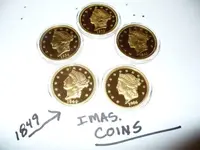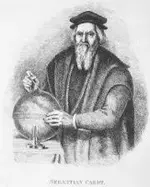Re: WHO AM I...............CONTEST READ TOP POST MODIFICATION.
TreasureTales said:
CORRECT
Good Job
James Barton Longacre was appointed chief engraver of the United States Mint on September 16, 1844, after the death of Christian Gobrecht. He served in the post until his death on January 1, 1869. Although he was assisted by others from time to time (most notably, Anthony C. Paquet), most new pattern designs made during his tenure were from his hand. He leaned heavily on certain work of his predecessor, as in his use in 1854-1855 of the flying eagle design Gobrecht had used on 1838 half dollars and his use in 1856-1858 of the flying eagle design first employed on Gobrecht's 1836 silver dollar. Also, Gobrecht's Liberty Seated motif furnished an inspiration for certain Longacre seated figures.
However, much of Longacre's work was strictly his own, such as the Liberty Head used on the 1848 gold $1 and $20, the Indian Princess gold $1 and $3 of 1854, the lovely Indian Princess pattern silver coins of the late 1860s (also used by William Barber after Longacre's death), the two-cent piece, the Shield nickel and the vast array of pattern five-cent pieces of the 1860s,
and, most famous of all, the Indian Head cent. This is but a short list, and many other items could be added. In total, Longacre's dies were used on hundreds of different pattern coins and trial pieces.
Much of his work is of a high order of excellence, and he seems to have had an excellent sense of proportion. Walter Breen has condemned Longacre for ineptitude, including the creation of many blundered dies, but more likely these date-punching and other errors were done by workmen supervised by Chief Coiner Franklin Peale, not by Longacre.
James B. Longacre was born in Delaware County, Pennsylvania on August 11, 1794. Young Longacre served as an apprentice to bookseller James F. Watson of Philadelphia for a short time, then continued his apprenticeship with George Murray, prolific banknote engraver of the same city who at one time also employed Christian Gobrecht. Longacre set out on his own in 1819 and engraved metal plates for bank notes and book illustrations, including for a work on signers of the Declaration of Independence and another on stage personalities. S.F. Bradford's Encyclopedia, 1820, contains his work. In 1830, Longacre and James Herring laid plans for a series of biographies of famous men in the military, political, and other fields. This took form in the National Portrait Gallery of Distinguished Americans, of which the first of four volumes was published in 1834. This last work was published in multiple large print runs, was widely circulated, and brought great fame to Longacre and others whose work was included. Today in 1999, while these volumes are hardly common, a modest amount of time spent in inquiries with sellers of antiquarian books will probably turn up a set.
Through the influence of John C. Calhoun, Longacre was appointed as chief engraver at the Mint on September 16, 1844, to succeed the late Christian Gobrecht. While Gobrecht had been a medalist and coin engraver of high repute, Longacre's experience in the medium of struck pieces was limited or nonexistent. However, he was a talented artist, seems to have learned quickly, and by 1849 created his first major new coinage design, the Liberty Head for the gold dollar and double eagle, this project being quite complex and bringing criticism to the engraver when problems were found with the high relief of the portrait. However, adjustments were made, and the design endured on the double eagle until well into the following century, to 1907.
At the Mint during his tenure, particularly in the late 1850s and through the 1860s, various local engravers assisted him, these including William Barber and Anthony C. Paquet-both of whom became well known-and, less well known, P.F. Cross and William H. Key. The latter had an active business in Philadelphia and produced many store cards, tokens (including many connected with the Civil War series), and medals. Neither Cross nor Key are remembered or cited in the annals of pattern coinage, although no doubt they did some of the work on dies we associate with Longacre.
The chief engraver seems to have had little patience with certain of his associates and superiors in the Mint and thus became involved in several notable disputes. In particular, for a long time he was opposed by Chief Coiner Franklin Peale, who ran his own private business using Mint facilities and who was involved in many shenanigans, until he was fired by President Franklin Pearce in December 1854, after which point Longacre had an easier time.
In 1867, Longacre and Anthony C. Paquet (who worked as an assistant engraver at the Mint, but who was now back in the private sector, but doing contract work for the Mint) redesigned and/or modified certain coins for the government of Chile. None of these motifs bear any resemblance to contemporary American coinage, however. Longacre did other commission work from time to time, quite possibly including certain dies for private California coiners (Dubosq is a strong possibility; the principals of that firm left Philadelphia to seek their fortunes in the Land of Gold).
Longacre remained chief engraver until his death on January 1, 1869. On January 4, at the Mint at noon all the officers, clerks, and workers gathered to pay tribute to the late engraver. Dr. Henry R. Linderman delivered an address, William Barber eulogized, and William E. Dubois presented resolutions. On January 21, 1870, coins from Longacre's estate were auctioned by Thomas & Sons, 139 and 141 South Street, Philadelphia. Included were patterns, Chilean coins, regular issues, etc. Longacre's books, art objects, etc., were scheduled to be sold at a later date.
In 1928 the New York Public Library mounted an exhibit of the work of 100 notable American engravers, including works by Longacre. In October 1985 in The Numismatist, in "Longacre, Unsung Engraver of the U.S. Mint," an article by Tom DeLorey, sketched the biography of this important 19th-century man, an engraver who was misunderstood in his time, but who later became a household word in the numismatic community. The DeLorey text was illustrated by sketches and photographs of patterns, a number of which had not been published earlier.
The following is probably Longacre's most famous pattern, J117/P132 - the 1849 double eagle.








